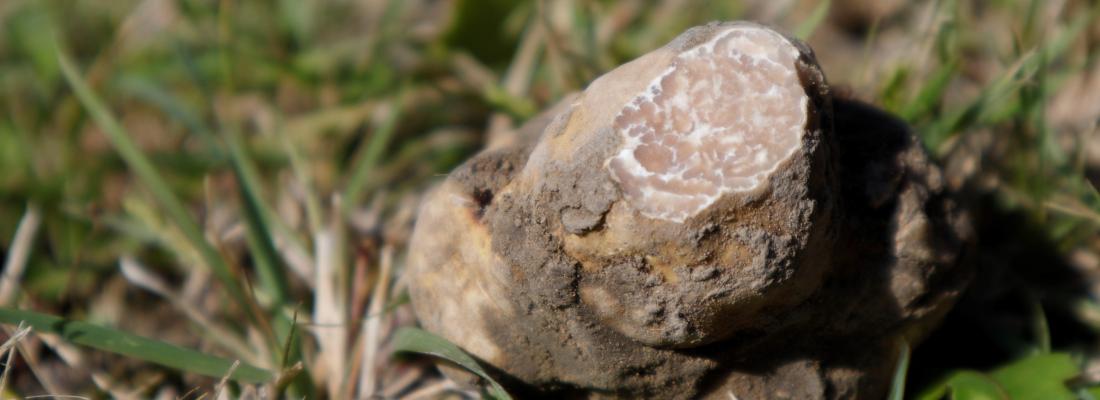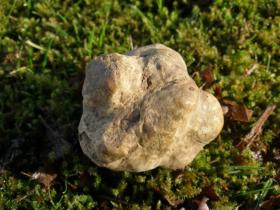Society and regional strategies Reading time 4 min
Controlled production of white truffles Made in France: a global first
Published on 16 February 2021

This truffle can be sold for between €1500 and €3000 per kilo. But prices soar each year during the auction season, when they can reach €50,000 per kilo!
The Italian white truffle (Tuber magnatum Pico) is the most prized by many gastronomic restaurants throughout the world. Its distinctive aroma already made it unique in the 1700s when the Princes of Savoy used it as a tool in their diplomatic negotiations. The ascocarps (truffles) of T. magnatum are produced by a fungus that lives in symbiosis with trees such as oak, willow, hornbeam and poplar. This truffle is harvested naturally in Italy and the Balkan peninsular, and more rarely in Switzerland and south-eastern France. Its annual production is only a few tens of tonnes. Attempts to cultivate T. magnatum started in the 1970s in Italy, where more than 500,000 plants were sold. The first truffles were harvested 15 to 20 years after planting, but only in around ten orchards that were all within the natural range for this truffle. It is therefore impossible to confirm whether this production was due to the trees planted or the truffle being naturally present in these regions.
Each plant is thus verified individually by INRAE experts before it is sold.
Since 2008, Pépinières ROBIN has thus been selling trees mycorrhized with T. magnatum according to the process developed by INRAE/Pépinières ROBIN, under license to and controlled by INRAE. Each plant is thus verified individually by INRAE experts before it is sold; they check for the presence of the fungus by analysing morphological traits and performing DNA analyses. In the context of a joint INRAE/Pépinières ROBIN research programme, five French orchards were studied. The first result was the persistence of white truffle in the soil three to eight years after the trees had been planted in four orchards in French regions with differing climates (Rhône-Alpes, Bourgogne Franche Comté and Nouvelle Aquitaine). The principal result of these efforts was the harvest of three truffles in 2019 and four in 2020 from the orchard in Nouvelle-Aquitaine. These are therefore the first truffles to be harvested in an orchard outside the natural distribution range of this species.
Truffle growing has seen considerable global growth in recent years. In France it is also developing in many regions, enabling farmers to diversify their activities while respecting the environment: truffles are an agroecological crop that does not require chemical inputs and favours biodiversity. The results of this study now open the way towards the cultivation of T. magnatum outside its natural distribution range, on condition of planting high-quality mycorrhized trees in appropriate soils and ensuring the correct management of orchards.
Joël Giraud, French Minister of State for Rural Affairs, attached to the Minister for Territorial Cohesion and Relations with Local Government praised this world first in truffle-cultivation.
"As former MP of the Hautes-Alpes and member of the government in charge of rural territories, I would like to congratulate this world first in truffle growing. It is a perfect illustration of the capacity of rural areas to innovate, which the government supports and encourages." Joël Giraud, French Minister of State for Rural Affairs, attached to the Minister for Territorial Cohesion and Relations with Local Government.
|
A fungus worth its weight in gold 
Truffles are fungi that live in strict association with trees (mycorrhizal symbiosis) where each benefits from the other. The truffle draws from the soil the minerals that are essential for the tree, which in exchange supplies sugar to the truffle. There are 180 truffle species in the world, but only a few are of gastronomic and economic interest. The best known are the black truffle (Tuber melanosporum Vittad), the summer or autumn truffle (Tuber aestivum Vittad) and the white truffle (Tuber magnatum Vittad). The white truffle, better known as the Alba or Piedmont white truffle, is mainly harvested in the Balkans and Italy where it is a crucial component of the cultural heritage. At a European scale, it is of considerable economic importance, with forest harvesting alone generating income estimated at €0.9 billion a year. Because supply is always much lower than demand, this truffle with its distinctive aroma can be sold for between €1500 and €3000 per kilo. But prices soar each year during the auction season, when they can reach €50,000 per kilo! |
|
Reference Bach, C., Beacco, P., Cammaletti, P. et al. First production of Italian white truffle (Tuber magnatum Pico) ascocarps in an orchard outside its natural range distribution in France. Mycorrhiza (2021). https://doi.org/10.1007/s00572-020-01013-2 |
|
The INRAE/ROBIN research program Truffle cultivation is based on the technique of controlled mycorrhization, a symbiotic relationship between a young tree - such as an oak - and a fungus, the truffle. Plants mycorrhized with black truffle (T. melanosporum), also called truffle plants, were developed during the 1970s by INRA in Clermont-Ferrand. Today, 90% of black truffle production in France comes from orchards of mycorrhized plants. For the white truffle (T. magnatum) controlled mycorrhization has been much more difficult to develop, which is why until now it could only be harvested in forests. A partnership between INRAE and Pépinières ROBIN, initiated in 1999, has enabled the development of a reliable method for the large-scale production of plants mycorrhized with T. magnatum. This joint research programme led to the breeding of the first mycorrhized plants in 2003. In order to valorise this exclusive know-how through the production and sale of plants mycorrhized with T. magnatum, Pépinières ROBIN signed a right of option for a license with INRAE Transfert. In 2008 this right of option became a licensing agreement for exploitation of the INRAE/ROBIN process. The mycorrhized plants thus produced are now sold by Pépinières ROBIN following individual morphological and DNA controls by INRAE staff. |
